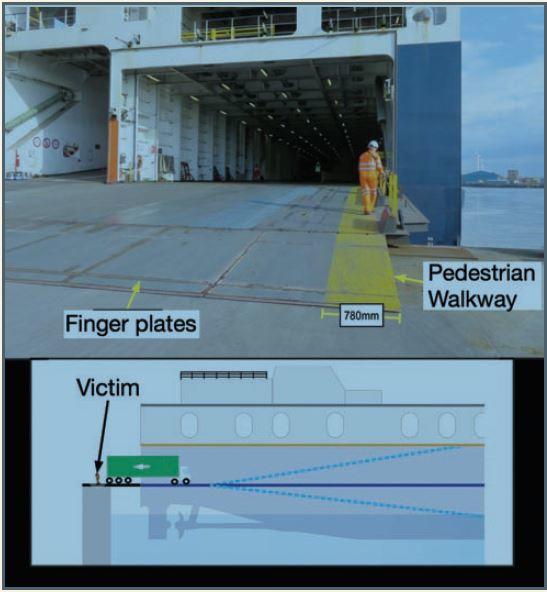202067 Weak procedures and telephone distractions create a fatal combination
As edited from official MAIB (UK) report 10/2020
Semi-trailers were being discharged from the hold of a ro-ro vessel by tractor units belonging to the terminal. A tractor was pushing a semi-trailer up the lower vehicle deck ramp and then down the vessel’s stern ramp and onto the quay. One of the vessel’s officers, dressed in an orange boiler suit, was standing near the stern ramp. He started a personal call on his mobile telephone. While he was talking, he walked along the starboard side of the main vehicle deck and on to the starboard side of the stern ramp.
As the officer talked on his phone, he remained standing on the stern ramp’s starboard side, gradually moving down the ramp towards the quay with his back to the vessel. Meanwhile, the semi-trailer being pushed down the ramp was approaching. Another tractor driver, in his cab on the quay, saw the danger and sounded his horn to give warning. Approximately three seconds later, the rear of the semi-trailer struck the victim, fatally injuring him.
The official investigation found that the tractor driver’s view ahead was blocked by the semi-trailer; the victim would not have been visible to him. Furthermore, he was not expecting pedestrians to be standing on the ramp directly ahead of his vehicle. The victim had probably not heard the semi-trailer approaching as the sound of the tractor’s reversing alarm and its engine would have been masked by the ambient
noise of the vessel. Also, the reversing alarm would have been absorbed or reflected to some degree by the semi-trailer between the tractor and the victim, to say nothing of the victim holding a phone to his ear and being absorbed in a conversation.

Lessons learned
- Relying on a strategy of ‘see and be seen’, with the onus on pedestrians to keep out of the way, has fundamental weaknesses. Among other things, it does not take into account the limited visibility from a cab pushing a semi-trailer or the potential for distractions.
- The potential for mobile phones to cause distraction in onboard workspaces has yet to be fully recognised and addressed by the marine industry.
The safety actions taken subsequent to this accident included:
- Updating loading procedure for the lower vehicle decks to ensure that discharge from the lower hold is by forward driving only.
- Updating company guidelines to prohibit pedestrians, including crew members, from being on the stern ramp at the same time as moving vehicles unless actively engaged in the loading/unloading of abnormal loads or vehicles with low ground clearance.
